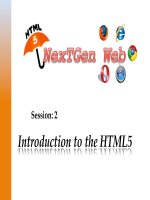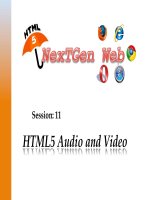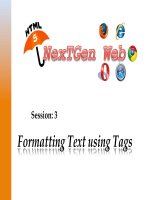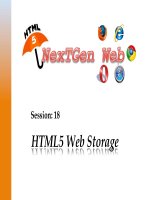HTML5 XP session 01 tủ tài liệu bách khoa
Bạn đang xem bản rút gọn của tài liệu. Xem và tải ngay bản đầy đủ của tài liệu tại đây (6.63 MB, 28 trang )
Session: 1
Introduction to the Web
the
evolu,on
of
HTML
Explain
Explain
the
page
structure
used
by
HTML
the
drawbacks
in
HTML
4
XHTML
List
List
the
new
features
of
HTML
5
CSS
Explain
Explain
JavaScript
Explain
jQuery
Explain
browser
support
for
HTML
5
©
Aptech
Ltd.
Introduc,on
to
the
Web
/
Session
1
2
Hypertext Markup Language was introduced in 1990.
HTML 5 was recommended as a standard by W3C in 1997.
HTML 5 is the next version and will be the new standard.
Majority of the browsers support HTML 5 element and Application Programming
Interface (API).
©
Aptech
Ltd.
Introduc,on
to
the
Web
/
Session
1
3
Computing started by using stand-alone computers to perform different computing
operations.
Later organizations began to connect their computers to share data.
Different types of networks are as follows:
Area
Network
(LAN)
Local
Area
Network
(MAN)
Metropolitan
Wide
Area
Network
(WAN)
©
Aptech
Ltd.
Introduc,on
to
the
Web
/
Session
1
4
Network in a small
geographical area
Network that covers
city
Network that connects
LANs and MANs across
the globe
©
Aptech
Ltd.
Introduc,on
to
the
Web
/
Session
1
5
WAN raised the need to share data across the globe rather than within an organization.
This resulted in the evolution of Web also known as World Wide Web (WWW).
Internet is known as the largest WAN.
Web is a way to access information using Internet.
Multiple computers are connected to each other irrespective of geographical locations.
©
Aptech
Ltd.
Introduc,on
to
the
Web
/
Session
1
6
Information is
available in the
form of Web pages
Web page is a file
containing
information and
instruction
Information is
displayed to the user
©
Aptech
Ltd.
Introduc,on
to
the
Web
/
Session
1
7
Web pages are stored on a Web server to make them available on the Internet for the
users.
Web server is a computer with high processing speed and connected to the Internet.
Web server is used to host and display the Web pages on a Web browser.
Web browser displays the Web pages using the HTTP protocol.
HTTP is a protocol that specifies how a Web page will be retrieved from the Web server.
©
Aptech
Ltd.
Introduc,on
to
the
Web
/
Session
1
8
Steps
to
view
a
Web
page
in
a
browser
are
as
follows:
1. User specifies the Uniform Resource Locator (URL) of Web page in a browser.
2. The client browser sends the URL request to the appropriate Web server.
3. Web server processes the request and sends the Web page as a response to the browser.
©
Aptech
Ltd.
Introduc,on
to
the
Web
/
Session
1
9
Contents remain
unchanged
Consists of content
such as text, images,
videos and so on
Static
Web
Pages
Focuses on content
presentation
Simple to design as it
provides no
interactivity
©
Aptech
Ltd.
Introduc,on
to
the
Web
/
Session
1
10
Allows customization
of content and its
appearance in
browser
Data is always upto-date and reliable
Dynamic
Web
Pages
Generates content
on-demand when
user provides input
Allows user interaction
©
Aptech
Ltd.
Introduc,on
to
the
Web
/
Session
1
11
Technologies
used
for
crea,ng
dynamic
Web
sites
are
as
follows:
JavaScript, a scripting language, is used for creating dynamic Web pages.
CSS specifies the formatting of a Web page for both static and dynamic Web pages.
Extensible HTML when used with JavaScript, displays the required user-defined data
each time the Web page is loaded in the browser.
Dynamic HTML uses JavaScript and CSS to make dynamic Web pages and transform
the look and feel of the Web pages.
©
Aptech
Ltd.
Introduc,on
to
the
Web
/
Session
1
12
has
evolved
over
the
years
with
the
introduc,on
of
improved
set
of
HTML
standards
and
specifica,ons.
HTML
3.2
HTML
4.0
HTML
5.0
HTML
3.0
©
Aptech
Ltd.
Introduc,on
to
the
Web
/
Session
1
13
Basic
rules
for
HTML
5
are
as
follows:
Introduction to new features should be based on HTML, CSS, DOM, and JavaScript.
More markup to be used to replace scripting.
Must be device independent.
Need for external plug-in to be reduced.
Better error handling capabilities.
Better visibility to public the development process.
©
Aptech
Ltd.
Introduc,on
to
the
Web
/
Session
1
14
HTML 5 contains a head section containing the unseen elements and the body section
containing the visible elements of the document.
Earlier HTML provided different tags to build and organize the content in the body of the
document.
The <table> tag was an element often used to present the data in an organized manner.
The <div> tag was another element used to display contents such as images, links, text,
menus, forms, and so on.
HTML 5 includes new elements that identify and organize each part of the document
body.
©
Aptech
Ltd.
Introduc,on
to
the
Web
/
Session
1
15
Contains links for
navigation
Has logo, name,
subtitles, and short
description of the
Web page
Contains links that
lead to certain item
present internally on
the Web site or an
external link
Contains product
lists, description of
products, blogs or
any other
information
Includes author or
company name, links
regarding rules, terms
and conditions, location
maps and other data
©
Aptech
Ltd.
Introduc,on
to
the
Web
/
Session
1
16
HTML 4 was a universally accepted standard for developing Web sites and is a stable
coding language.
HTML 4 is compatible with all important browsers.
HTML 5 adds new capabilities and provides improvements through better interactivity,
multimedia services, and application handling.
XHTML created with XML is a rigid, standard-based language.
XHTML was supposed to be the next version of XML but took a backseat because of
interoperability problem.
©
Aptech
Ltd.
Introduc,on
to
the
Web
/
Session
1
17
Provides new features
in CSS such as
advanced selectors,
drop-shadows and so
on
Provides new
features for mobile
applications
Provides client-side
storage and caching
functionality
HTML 5
Uses the Web
worker feature to
make JavaScript
efficient
Helps to create rich
Internet clients using
plug-ins such as
Flash
Gets rid of plug-in
and uses native
support for audio
and video
Provides descriptive
semantics
©
Aptech
Ltd.
Introduc,on
to
the
Web
/
Session
1
18
Browser loads the
document which
includes HTML
markup and CSS
style
©
Aptech
Ltd.
Browser creates an
internal model of the
document containing
HTML elements after
page load
Browser loads
the JavaScript
code which
executes after
page loads
APIs give access to
audio, video, and
other required
technologies to
build the app
Introduc,on
to
the
Web
/
Session
1
19
Web workers API is
added to support
background process
without affecting the
main process
Web sockets API
provides continuous
connection between a
server and a client
New form controls
Features
of HTML
5
<audio> and
<video> element
available for media
playback
Provides local
storage support
<canvas> element
used for drawing
Content specific
elements helps to
structure the document
©
Aptech
Ltd.
Introduc,on
to
the
Web
/
Session
1
20
Works along with HTML to provide visual styles to document elements.
Is a rule based language that specifies the formatting instructions for content in an
HTML document.
Purpose is to separate content from its formatting.
Can define the layout and formatting of content in a separate file with a .css extension.
Allows rules from different .css files to be merged or edited.
task
of
combining
and
matching
rules
from
different
files
is
referred
to
as
This
cascading.
©
Aptech
Ltd.
Introduc,on
to
the
Web
/
Session
1
21
Code Re-usability
Benefits
of CSS
Device Independence
Less HTML code
©
Aptech
Ltd.
Introduc,on
to
the
Web
/
Session
1
22
User requests
for a Web page
from the
browser using
the URL
©
Aptech
Ltd.
Server responds with the
HTML file and related
file such as image files,
audio files and so on
Browser executes the CSS
code using the rendering
engine and applies the
styles to CSS files
Web page is then
displayed to the
browser
Introduc,on
to
the
Web
/
Session
1
23
©
Aptech
Ltd.
Introduc,on
to
the
Web
/
Session
1
24
Functionality of JavaScript
Allows
a
user
to
create
2D
drawable
surface
in
your
page
without
using
plug-‐ins.
Use
Web
Workers
to
turbo
charge
the
JavaScript
code
to
perform
advanced
computa,on.
Accesses
any
Web
service
and
brings
back
the
data
to
the
applica,on
in
real
,me.
Does
not
require
any
special
plug-‐ins
to
play
video.
Allows
to
create
own
playback
controls
using
JavaScript
and
HTML.
Uses
browser
local
storage
and
does
not
require
browser
cookies.
Can
perform
full
video
processing
in
the
browser.
©
Aptech
Ltd.
Introduc,on
to
the
Web
/
Session
1
25









